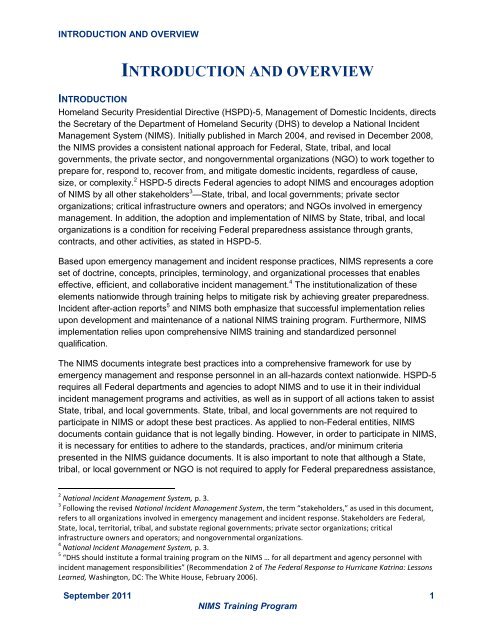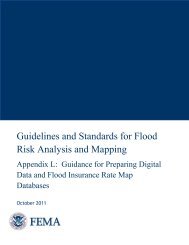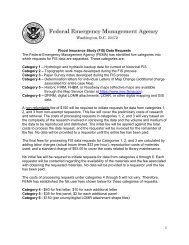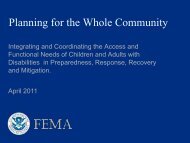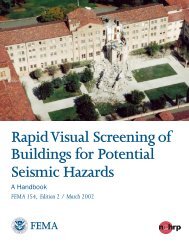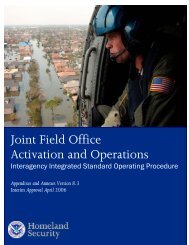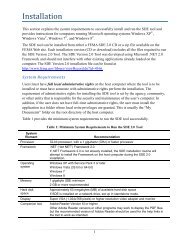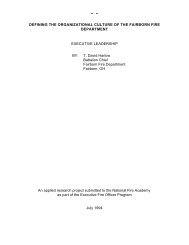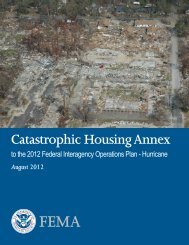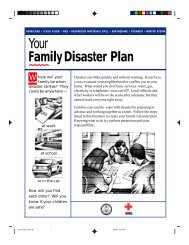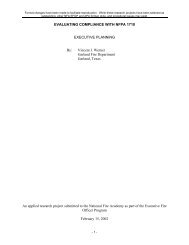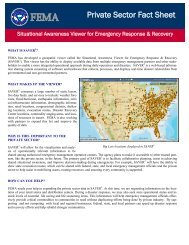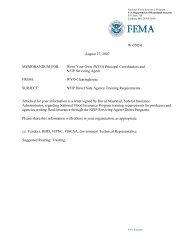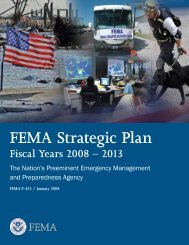NIMS Training Program - Federal Emergency Management Agency
NIMS Training Program - Federal Emergency Management Agency
NIMS Training Program - Federal Emergency Management Agency
You also want an ePaper? Increase the reach of your titles
YUMPU automatically turns print PDFs into web optimized ePapers that Google loves.
INTRODUCTION AND OVERVIEW<br />
INTRODUCTION AND OVERVIEW<br />
INTRODUCTION<br />
Homeland Security Presidential Directive (HSPD)-5, <strong>Management</strong> of Domestic Incidents, directs<br />
the Secretary of the Department of Homeland Security (DHS) to develop a National Incident<br />
<strong>Management</strong> System (<strong>NIMS</strong>). Initially published in March 2004, and revised in December 2008,<br />
the <strong>NIMS</strong> provides a consistent national approach for <strong>Federal</strong>, State, tribal, and local<br />
governments, the private sector, and nongovernmental organizations (NGO) to work together to<br />
prepare for, respond to, recover from, and mitigate domestic incidents, regardless of cause,<br />
size, or complexity. 2 HSPD-5 directs <strong>Federal</strong> agencies to adopt <strong>NIMS</strong> and encourages adoption<br />
of <strong>NIMS</strong> by all other stakeholders 3 —State, tribal, and local governments; private sector<br />
organizations; critical infrastructure owners and operators; and NGOs involved in emergency<br />
management. In addition, the adoption and implementation of <strong>NIMS</strong> by State, tribal, and local<br />
organizations is a condition for receiving <strong>Federal</strong> preparedness assistance through grants,<br />
contracts, and other activities, as stated in HSPD-5.<br />
Based upon emergency management and incident response practices, <strong>NIMS</strong> represents a core<br />
set of doctrine, concepts, principles, terminology, and organizational processes that enables<br />
effective, efficient, and collaborative incident management. 4 The institutionalization of these<br />
elements nationwide through training helps to mitigate risk by achieving greater preparedness.<br />
Incident after-action reports 5 and <strong>NIMS</strong> both emphasize that successful implementation relies<br />
upon development and maintenance of a national <strong>NIMS</strong> training program. Furthermore, <strong>NIMS</strong><br />
implementation relies upon comprehensive <strong>NIMS</strong> training and standardized personnel<br />
qualification.<br />
The <strong>NIMS</strong> documents integrate best practices into a comprehensive framework for use by<br />
emergency management and response personnel in an all-hazards context nationwide. HSPD-5<br />
requires all <strong>Federal</strong> departments and agencies to adopt <strong>NIMS</strong> and to use it in their individual<br />
incident management programs and activities, as well as in support of all actions taken to assist<br />
State, tribal, and local governments. State, tribal, and local governments are not required to<br />
participate in <strong>NIMS</strong> or adopt these best practices. As applied to non-<strong>Federal</strong> entities, <strong>NIMS</strong><br />
documents contain guidance that is not legally binding. However, in order to participate in <strong>NIMS</strong>,<br />
it is necessary for entities to adhere to the standards, practices, and/or minimum criteria<br />
presented in the <strong>NIMS</strong> guidance documents. It is also important to note that although a State,<br />
tribal, or local government or NGO is not required to apply for <strong>Federal</strong> preparedness assistance,<br />
2 National Incident <strong>Management</strong> System, p. 3.<br />
3 Following the revised National Incident <strong>Management</strong> System, the term “stakeholders,” as used in this document,<br />
refers to all organizations involved in emergency management and incident response. Stakeholders are <strong>Federal</strong>,<br />
State, local, territorial, tribal, and substate regional governments; private sector organizations; critical<br />
infrastructure owners and operators; and nongovernmental organizations.<br />
4 National Incident <strong>Management</strong> System, p. 3.<br />
5 “DHS should institute a formal training program on the <strong>NIMS</strong> … for all department and agency personnel with<br />
incident management responsibilities” (Recommendation 2 of The <strong>Federal</strong> Response to Hurricane Katrina: Lessons<br />
Learned, Washington, DC: The White House, February 2006).<br />
September 2011 1<br />
<strong>NIMS</strong> <strong>Training</strong> <strong>Program</strong>


